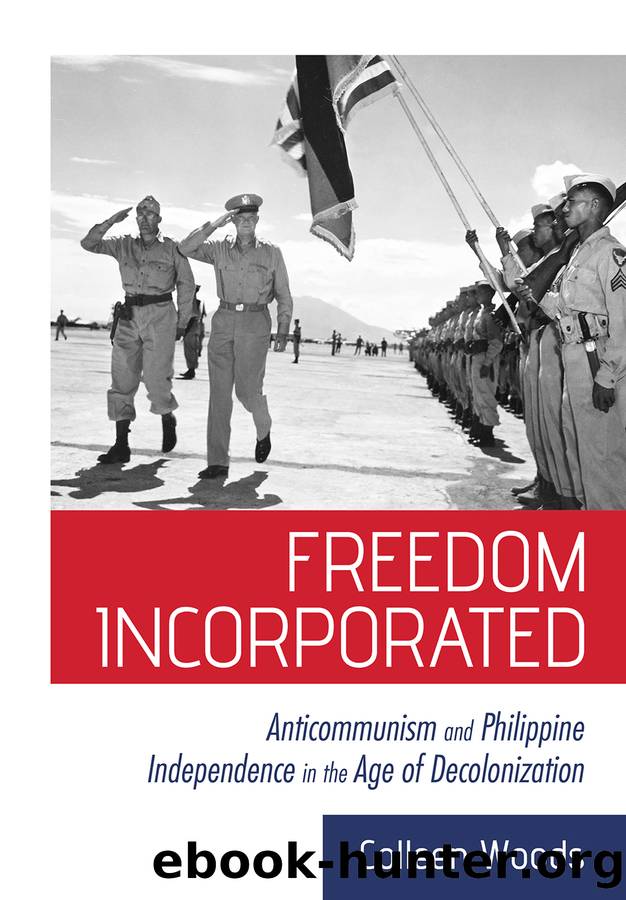Freedom Incorporated by Colleen Woods

Author:Colleen Woods
Language: eng
Format: epub
Publisher: Cornell University Press
Public Administration
In the context of decolonization and hardening Cold War battle lines, Southeast Asian foreign aid was unavoidably politicized, leading both Americans and Filipinos to manage its optics and messaging. In light of both contexts, the Philippines took on new meaning in U.S. foreign policies, and Americans acted accordingly by remaining attentive to questions of Philippine sovereignty. Members of the Bell survey mission, for instance, expressed concerns that technical assistance training programs might find themselves âon ticklish groundâ because of how they would likely infringe on âthe sovereignty of the Philippine government.â If policymakers wanted the solutions proposed through technical aid projects to be adopted, then it could not appear as if they had been entirely directed or controlled by the United States.46 Americans wanted to avoid accusations of imperial interference in the Philippines; but, ironically enough, when, in 1951, a group of U.S. policymakers gathered to discuss the Mutual Security Agencyâs (MSA) âAction Plan in Asia,â they met in the Philippine city of Baguio, home to âthe Mansion House,â built in 1908 to serve as the summer residence for the American governor general of the colonial state. The Philippine government had rehabilitated the mansion after it had suffered damage during WWII and used the mansion and its guesthouse as meeting venues, including for the second meeting of the United Nations Food and Agricultural Organization in 1948. Nonetheless, the fact that Quirino met U.S. officials at the site served as a reminder that the built environment of the U.S. colonial state remained visible in the independent state.
The MSA, a newly formed governmental division whose director served on the National Security Council (NSC), was modeled in part on the Marshall Plan in Europe, which U.S. policymakers believed, thanks to âtheir joint endeavors,â had âpreserved Europe and its civilization from collapse.â Citing President Trumanâs belief that U.S. foreign aid should support the âfree nations of Asia in their efforts to strengthen the economic foundations of independence,â the Baguio group identified training in public administration as a primary goal of U.S. foreign aid dollars.47 The Bell Report had already recommended a program of technical assistance for the Philippines, and the MSA group in Baguio identified the specific priority of public administration education.
As an academic discipline and subfield of political science, public administration originated in the late nineteenth century when academicsâincluding future president Woodrow Wilsonâargued for the need to study, and educate about, the bureaucratic systems of increasingly complex governments.48 Advocates of public administration suggested that it made democracy possible through the efficient use of resources, scientific methods of management, and the enforced separation of politics from administration; put another way, they stressed the benefits of a government bureaucracy run by experts rather than political appointees. As a result, universities began developing academic programs in the subject.49 In 1917, the political science department at the University of Michigan, for example, began granting masterâs degrees in municipal administration to promote efficiency in local governance; twenty-two years later, the university broadened its reach by founding the
Download
This site does not store any files on its server. We only index and link to content provided by other sites. Please contact the content providers to delete copyright contents if any and email us, we'll remove relevant links or contents immediately.
The Rape of Nanking by Iris Chang(3531)
The Sympathizer by Viet Thanh Nguyen(3528)
World without end by Ken Follett(3016)
Ants Among Elephants by Sujatha Gidla(2932)
Blood and Sand by Alex Von Tunzelmann(2615)
Japanese Design by Patricia J. Graham(2565)
City of Djinns: a year in Delhi by William Dalrymple(2140)
Inglorious Empire by Shashi Tharoor(2108)
In Order to Live: A North Korean Girl's Journey to Freedom by Yeonmi Park(2064)
Foreign Devils on the Silk Road: The Search for the Lost Treasures of Central Asia by Peter Hopkirk(2061)
Tokyo by Rob Goss(2025)
India's Ancient Past by R.S. Sharma(1994)
India's biggest cover-up by Dhar Anuj(1992)
The Great Game: On Secret Service in High Asia by Peter Hopkirk(1965)
Tokyo Geek's Guide: Manga, Anime, Gaming, Cosplay, Toys, Idols & More - The Ultimate Guide to Japan's Otaku Culture by Simone Gianni(1953)
Goodbye Madame Butterfly(1942)
The Queen of Nothing by Holly Black(1770)
Living Silence in Burma by Christina Fink(1738)
Batik by Rudolf Smend(1726)
